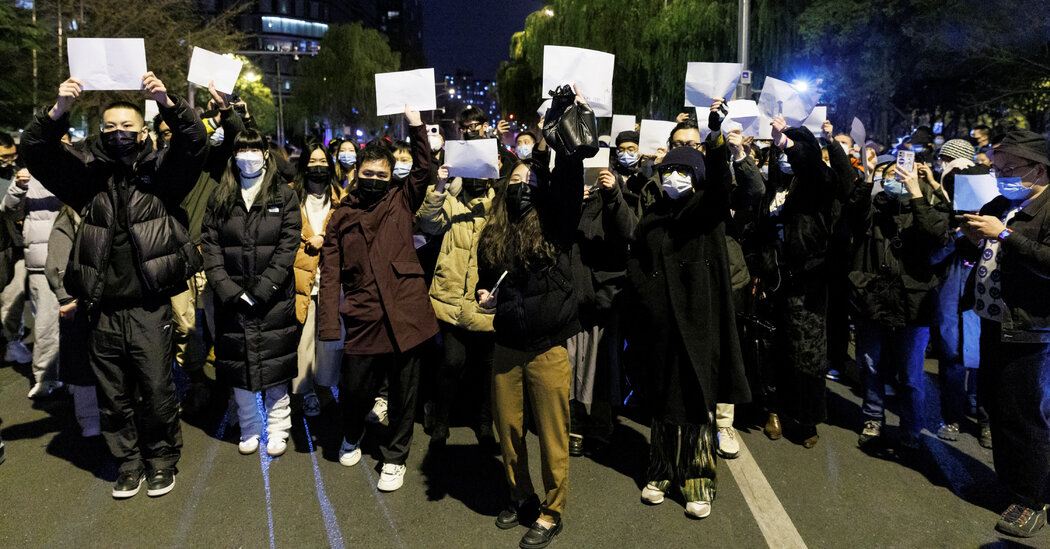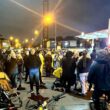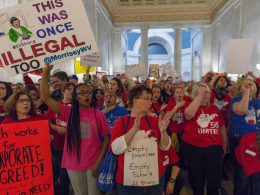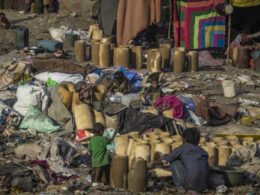By Li Yong and Vincent Kolo, chinaworker.info
At the time of writing, police are massing in Chinese cities in an effort to stamp out the recent protest wave. Protests continue at universities. The coming weekend could see new street protests in cities across the country. The demonstrations that swept China in the past few days represent the most serious challenge for thirty years to the so-called Communist Party (CCP) dictatorship and its newly crowned ‘Emperor’ Xi Jinping.
After three years of suffocating and unspeakably brutal ‘Zero Covid’ controls and lockdowns, people have reached breaking point. While ‘Zero Covid’ and Thursday’s deadly blaze in Xinjiang acted as the trigger, the current protest wave is much more than an ‘anti-lockdown’ movement, important as that issue is.
Student protests at more than 80 universities around the country have shouted “Freedom or death” — a slogan from the 1989 struggle, which most Chinese youth are completely unaware of. Demands for democratic rights and an end to dictatorship have combined with outrage against the dictatorship’s insanely unscientific insistence at any cost of killing off an unkillable virus.
In the past week, daily Covid infection rates have reached a record tally of over 40,000. While this is still low compared to levels in many Western countries at the peak of the pandemic, the government’s response is invariably more lockdowns, because it has painted itself into a corner insisting that ‘Zero Covid’ will succeed.
The dictatorship has blindly followed a losing strategy, reinforced by Xi Jinping’s personal role: He has a) wielded ‘Zero Covid’ as a weapon in the internal CCP power struggle, forcing regional governments to show ‘loyalty’, b) he has used the policy to massively upgrade the dictatorship’s surveillance and control capabilities.
Xi’s ‘Zero Covid’ strategy has downplayed vaccination and focused instead on intensive mass testing, contact tracing, quarantine and brutally enforced lockdowns. One million Chinese — including the family of one of the authors — are right now in quarantine centers (fancang), widely described as “worse than prisons”. A record fifty cities with around a quarter of China’s population are currently in some form of lockdown, according to Nomura which provides weekly updates.
A major change now, a shift to the ‘coexistence with Covid’ stance adopted by most other governments, could overwhelm China’s under-resourced healthcare sector and lead to hundreds of thousands of deaths. A recent Bloomberg Intelligence study showed that China only has four ICU beds per 100,000 people, much lower than rates in developed countries. A u-turn now would also be a humiliating personal defeat for Xi Jinping, as this is seen as his flagship policy. Therefore, the dictator finds himself in “political zugzwang” as Bloomberg columnist Clara Ferreira Marques pointed out, using a chess term which means a player is forced to make a move, but every option makes the situation worse.
Warning signs
Signs of a coming social explosion have been clear. The mass breakout in October of thousands of workers from the world’s largest iPhone factory (Foxconn) in Zhengzhou, had a huge effect on mass consciousness as these scenes were widely viewed on social media despite the best efforts of the censors. The city of Urumqi, where the latest wave of unprecedented protests began, has been in lockdown for an excruciating 100 days, accompanied — as in almost all lockdowns — by shortages of food and medicines.
The lockdowns have given rise to a mental health crisis of unimaginable proportions. Already in 2020, a national survey found that nearly 35% of respondents were dealing with psychological distress as a result of the pandemic. This year, the health ministry has refused to release suicide statistics.
Many of the universities that have now erupted in spontaneous anti-lockdown and anti-government protests have experienced several waves of lockdown, with students trapped for weeks in their dormitories, complaining of a lack of everything including sanitary products. When the football World Cup in Qatar kicked off, the effect in China was shocking. The sight of huge crowds with no masks or visible Covid restrictions prompted some to ask “is China on the same planet?”
A comrade in China described the situation as follows: “From what I can see in my social circle, apart from a few bureaucrats and young civil servants who do not comment at all, almost everyone is standing firm with the protesters — including the usual ‘silent majority’.”
“What is noteworthy about this storm is that the discontent with the Xi regime has come to the forefront, with the public no longer confining their anger to local officials or other members of the regime’s inner circle, but even Xi himself.”
Ten dead in Urumqi
The accumulated public anger over the ‘Zero Covid’ policy finally exploded on 26–27 November, as people gathered across the country to demand the lifting of the blockade, and even took it upon themselves to dismantle and destroy the fences and testing facilities, attacking pandemic prevention officers and police who were in the way. By 27 November, students from at least 85 universities across the country had staged protests, with numbers ranging from dozens to hundreds.
The incident was sparked by a fire on 24 November in an apartment block in a Uighur district of Urumqi, the capital of Xinjiang province. Urumqi is an 80% Han Chinese city. This has great significance when we see the spontaneous unity shown by Han and Uighurs, despite years of viciously racist CCP propaganda against Uighurs as “terrorists”.
The fire itself was not large, but fire engines were prevented from arriving in time to put out the fire due to barrier fences erected to enforce the lockdown. It is suspected that the victims were unable to escape because their doors and escape routes were locked. Video footage of people screaming for their doors to be opened was widely circulated online before being deleted by censors.
Ten people, all Uighurs, were killed in the fire, although some online reports suggest the death toll is higher. CCP officials later shirked their responsibility by denying the exits were blocked and blaming the residents for not knowing the escape routes. This further stoked public anger and that night a large number of Urumqi citizens, both Han and Uighurs, broke through the pandemic barriers and marched to the city government offices to protest.
The seeds of revolt have been planted in the hearts of the people as a result of successive collateral disasters leading to loss of life. This includes the bus crash in Guizhou province that killed 27 passengers being forcibly sent to a remote quarantine center, and countless tragedies of people dying because they were refused hospital admission without a negative PCR test.
In recent weeks, people and workers in places like Zhengzhou and Guangzhou have smashed through pandemic barriers and confronted the police. In Chongqing, a video of young people shouting “freedom or death” in front of the police lines struck a chord with many people. The protests in Urumqi set off a wave that spread across the country in two days, igniting the anger and discontent that has built up under the inhuman ‘Zero Covid’ policy, but which goes even deeper. Xi Jinping’s hardline pandemic policies have also exposed the reality of a suffocating, brutally repressive dictatorship for millions. It has shown the lengths the regime is prepared to go to with repression and surveillance.
“Down with the Communist Party!”
On the night of 26 November, people in Shanghai broke through the pandemic cordon and marched down Wulumuqi Road, named after the city of Urumqi, to pay tribute to the victims of the fire and vent their anger. Days later, the police removed all the street signs for Wulumuqi Road as part of their measures to prevent more protests. The crowd in Shanghai joined in chanting “Down with the Communist Party! Step down Xi Jinping!” They also physically blocked police cars and fought to free demonstrators who had been arrested by police. The demonstrations continued throughout the day and evening of 27 November, with people demanding the release of the arrested protesters. In addition to Shanghai, large protests broke out in Beijing, Nanjing, Guangzhou, Chengdu, Wukan and other cities.
Never since 1989 has China seen a movement on such a national scale. The current protests are not yet at that level, but we shall see how things develop. China’s economic and social crisis is in many ways more serious than even at that time. The current protests are drawn from many social layers: migrant workers as in Zhengzhou and Guangzhou, students, ethnic minorities such as Uighurs, and many young women in the front line of demonstrations. There are many different elements in the unfolding political consciousness, but this has already escalated beyond an anti-lockdown movement into posing political demands for democracy, against repression, for an end to the dictatorship and for the removal of Xi Jinping.
In Urumqi, the local government immediately did a u-turn after the fire announcing that the Covid outbreak in the city had been “cleared” and so controls were being relaxed. But people continued to take to the streets in protest. Many other governments have adopted a similar stance, hastily announcing the lockdowns are to be lifted and carrying out some cosmetic changes.
This is the classical CCP strategy for defusing protests with a mixture of an initial ‘carrot’ i.e. concessions, followed by the ‘stick’ of repression and arrests. Widespread scepticism has been expressed on social media, that as in Urumqi, the virus has instantly and miraculously disappeared. The CCP dictatorship is infamous for issuing ‘fake’ promises and concessions. It has demobilized countless environmental protests by announcing the polluting industries will be closed down, only to allow them to continue once the immediate unrest has been defused. In Wuhan, in Guangdong province, the CCP authorities promised limited local elections to defuse protests against land-grabbing and corruption. The elections were rigged and then the crackdown began with many of the protest leaders now in prison or in exile. “They gave us a cheque for a million dollars”, said one Wukan activist later, “but it bounced”.
In this wave of protests, Han Chinese and Uighurs have shown solidarity and overcome the divisive tactics of the CCP. There were heart-warming scenes in Urumqi of Han people being applauded and embraced by Uighurs passing by as they put up banners on the streets to mourn the victims of Thursday’s fire. Some media commentators in China described this situation as unprecedented since the July 5 Incident (deadly inter-ethnic riots and pogroms) in Xinjiang in 2009.
What demands?
On university campuses, large numbers of students joined in solidarity. At Tsinghua University in Beijing on 27 November, hundreds of students held up blank sheets of paper in protest, chanting “democracy, rule of law, freedom of expression” and “Long live the proletariat”, also singing the Internationale.
In contrast to earlier protests, the current wave shows a shift towards more explicit opposition to the dictatorship, with rare direct slogans against the CCP and Xi Jinping being taken up widely. Again, this is the first time since 1989. The Sitong Bridge incident in October, when a lone protester, Peng Lifa, hung banners in central Beijing with slogans against the dictatorship, has clearly influenced many of the demands that are being raised today. While a one-person protest would not have such a huge impact in most countries, in China, where all independent organisations, politics and democratic rights are banned, the effect has been electrifying.
In our statement on the Sitong Bridge protest (“New Tank Man protest gets huge response”, chinaworker.info, 17 October) we recognized this impact and praised many of the banner slogans while at the same time explaining this was not a sufficiently full or clear program for building a movement to challenge CCP rule. Some of the demands — supporting “reform” — unfortunately, reinforce the illusion that the dictatorship, or some of its elite factions, are capable of reforming and offering democratic concessions.
Time and again the CCP has shown that this is a false postulate. The CCP’s one-time promise to allow limited democratic rights in Hong Kong was withdrawn and smashed. If the CCP could not tolerate a mangled and limited form of bourgeois ‘democracy’ in the relatively separate entity of Hong Kong they surely cannot tolerate this in China.
Marxists and chinaworker.info have shown in our articles that no autocratic system in history has ever been “reformed” out of existence. Mass struggles, mostly spearheaded by a strike wave and decisive interventions by the workers’ movement, have always been the key ingredients of a successful movement to defeat a dictatorial regime and win democratic rights. The defeat and subsequent suppression of the Hong Kong movement in 2019, despite the heroic efforts of its people, shows that there is no possibility of “reform”, no meeting halfway, with a dictatorship which by its nature must keep full control.
Mass anger against the ‘Zero Covid’ policy, which is personally identified with Xi Jinping, has further fuelled the mood against the dictatorship. The outbreak of protests is undoubtedly a humiliation and a serious setback for Xi, who has just begun his third term in office. At the time of Xi’s coronation, at the CCP’s 20th Congress, we predicted, “Whatever the outcome it will not fundamentally change the perspectives for the CCP regime, which is heading into the greatest of all storms” (chinaworker.info, Xi Jinping’s 20th Congress caps five years of political disasters, 17 October).
There are many similarities between today’s situation in China and the Iranian uprising. In both cases, a brutal incident triggered a nationwide protest movement in which political demands against the whole regime began to come to the fore. Impressive unity between different ethnic groups instinctively overcoming vicious racist and nationalist propaganda has also featured. Also, in Hong Kong in 2019 the mass movement broke out over the issue of a new extradition law, yet within weeks this issue had been overtaken as wave after wave of street protests focused their demands on democratic rights and ending state repression.
Lessons from Hong Kong
A significant feature of today’s protests in China are the many public expressions of regret that “We should have supported Hong Kong”. This shows the process of consciousness beginning to catch up. For the struggle in China to go forward there are crucial lessons from what caused the defeat of the Hong Kong movement. It did not lack numbers or militancy. But it lacked mass organisations especially workers’ organisations to sustain the struggle through many unexpected turns, government attacks and misinformation. It was isolated to one city and therefore could not hope to defeat the CCP dictatorship by standing alone. The dominance within the Hong Kong struggle of liberal ideology, the bankrupt compromise strategy of the pan-democratic opposition parties, alongside the even more extreme inward-looking mentality of the Hong Kong localists, became a self-inflicted hindrance.
An anti-organization philosophy, relying only on spontaneity and online platforms, also hobbled the Hong Kong struggle, because when facing a ruthless state with enormous resources, planning, strategy, the development of a clear program, understanding of an alternative society and system of government are all needed. And this requires organization: workers’ and students’ unions, grassroots protests committees, and critically also a working-class party with a clear program of democratic rights and socialism.
The latter would show that the CCP dictatorship is inextricably bound together with Chinese capitalism. It is the world’s biggest industrial and financial corporation, with its own army and police force. Illusions in capitalist democracy, which usually and perhaps inevitably fill a space in every anti-authoritarian struggle, need to be countered with clear warnings — as we did during the Hong Kong struggle — that the only way to win democratic rights is to break decisively with capitalism, the system upon which the CCP dictatorship rests.
Xi Jinping, as usual, has disappeared from view in the face of a major crisis, but we cannot underestimate the determination and ferocity of the CCP’s cold-blooded repression. The CCP will not accept the demands of the masses lightly, even partial demands for a change in the pandemic policy, for fear that it will boost their morale and cause a chain reaction that will lead to more mass struggles. Much less will the CCP accede to even limited democratic reforms that in the context of China, its sheer size and deep social and economic problems, would blow the dictatorship apart.
The key social force in China as everywhere is the working class, which is already a significant factor in the protests, but has no organizations of any description, not even trade unions to fight for its conditions at work. The working class, by organizing itself firstly at the point of production and then in society at large, is the natural and in fact only consistent driving force of a successful movement against repression, dictatorship and capitalism.
To place themselves at the head of the current protest wave, workers must raise the call for a strike movement, appealing also to the students to follow suit. A general strike would be the most powerful weapon against Xi’s dictatorship, if it was linked to organization through strike committees, new independent labour unions and a new workers’ party of democratic socialism.
We call for:
- Active solidarity with the mass revolt in China — build for more protests.
- No more lockdown, end ‘Zero Covid’ insanity.
- Massive resources to build up and equip the health sector, step up the vaccination program and immediately end the ban on foreign mRNA vaccines.
- Take the pharmaceuticals and super-profitable Covid companies into democratic public ownership without compensation, pour their resources into the public hospital system.
- Young people and graduates want decent jobs and salaries, raise minimum wages, nationalise any company that does not pay its workers.
- Build a strong welfare system, decent pensions, medical and unemployment insurance for all.
- Immediate and full democratic rights: freedom of speech, freedom of the press, close down the censors, freedom of assembly, the right to strike, the right to organize.
- Build independent and democratic workers’ and students’ unions.
- For a nationwide workers’ and students’ strike against the lockdowns and against dictatorship.
- Build underground committees to coordinate, strategize and build the mass struggle. Use social media but recognise its limits — real organisation is needed as the defeat in Hong Kong of a purely spontaneous movement shows.
- Release political prisoners.
- Abolish the national security law. Abolish the prison camps. Democratic rights for Hong Kong, Tibet and Xinjiang including the right of self-determination.
- United struggle by working class people in China, Hong Kong, Xinjiang and Taiwan against nationalism and capitalism.
- Down with dictatorship. Down with state repression. Disband the secret police.
- For a revolutionary people’s assembly elected by universal suffrage, with a mandate to introduce genuine socialist policies to confiscate the wealth of the billionaires and red capitalists.
- For international socialism. No Cold War but class war against the capitalists East and West.












